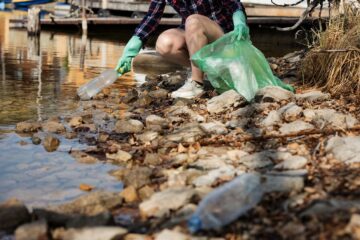![]()
“For every drop of water you waste, you must know that somewhere on earth someone is desperately looking for a drop of water!”
Mehmet Murat Ildan
Introduction:
The water crisis is a serious issue in many parts of the world. As per in 2018, the world population is 759.43 crores. And all these 759.43 crores of the world population need water for their livelihood. And one might be overjoyed by hearing that water covers about 71% of the earth’s surface but in this total percentage of water surface, 97% of the earth’s water is found in the ocean which is too salty for drinking, growing crops, and for most industrial uses. Only 3% of the earth’s water is fresh. And in this 3% of useful and freshwater is severally used. Water can be directly and indirectly in any form. Direct use of water includes bathing, drinking, cooking, etc. and indirect uses of water are for processing wood into paper, various other industries, etc. The bulk of the world’s water is used in agriculture, industry, and electricity. Apart from all these most common uses of water are as follows:
- Drinking and household needs.
- Recreation.
- Industry and commerce.
- Agriculture.
- Thermoelectricity/energy.
Recapitulation
Now, what is first to be understood is ‘what is the water crisis’? Water crisis is also known as water scarcity. ‘Crisis’ means any event that is going (or is expected) to lead to an unstable and dangerous situation affecting an individual, group, community, or whole society. And ‘scarcity’ means limited availability of a commodity which is in huge demand. And after understanding the intense meaning of two such words and adding water before them are making the situation more severe. Water is a natural resource that is important for our livelihood. Crisis or scarcity of water is a serious issue that needs great concern and a solution for the existence of the human race. The water crisis is the unavailability of sufficient water for both natural vegetation and human beings. It is the fact that water is unequally allocated all over the earth and this unequal distribution is mostly wasted, polluted, or unsustainably managed or handled.
Today, we cannot say that this water scarcity is worldwide but affirmatively there are places and regions where this problem of water crisis is present but that too is because of its increasing utilization due to continuous population augmentation. In recent times if we see this pressure on this natural amenity, it is existing in several parts of the world, for instance, China, India, Pakistan, in the Middle East, and many countries and regions of Africa. Nearly 1.8 billion people in 17 countries, or we can say that quarter of the world’s population, appear to be heading towards a water crisis- with such severe water shortages in the next coming few years.
Causes or Main Sources of Water Crisis
Pollution
There is enough water to sustain the human race if we deduct pollution from it but that’s the gut-wrenching fact that pollution has degraded the quality of water which is just contributing to its shortage. This pollution decreases the consumable quality of water as it becomes unfit and subsequently it reduces the availability of water. Pollution is becoming one of the threats to the water crisis day by day. Pesticides, discharging industrial wastes in rivers, washing clothes and animals in rivers and ponds, soil depletion, etc are some common causes for its deteriorating condition.
Overuse of Water
After pollution one of the biggest reasons is over and mal-management use of water. It is fact that there is plenty of uses of water resources but apart from using it there is inadequate management agriculture or industrial use or domestic use, water resources are used on one hand and on the other hand lots of water get wasted as margin running taps, unnecessary use in car washing, not preserving rainwater, etc are some examples of it.
Climate Change
The 3% water which is present on earth for use, some of that percentage is present in form of glaciers and ice packs which eventually are a source of water but due to global warming as a consequence, there are increasing rates of drought, floods, heat waves also happening. So the cause of climate change is working as the most worsening catalyst in the water crisis.
Growing Freshwater Demand
Over the years the fact which cannot be ignored is the boom of the population. As the population increases the demand for water is also increasing for cooking, drinking, and other needs also, and it is also true that in the coming years the population will increase more and more, need of the hour to manage these water resources efficiently.
Effects of Water crisis
Hunger, Poverty, and Education
Till the date lack of water results in dehydration but an intense sight can make you see some more serious consequences like hunger. The water crisis results in a crop shortage. Water is necessary for agriculture and eventually shortage of water results in a lack of food and then starvation. Due to this lack of food, people severely got poverty-stricken and this poverty and lack of water restrict the way of education for children as either they don’t have enough means to afford educational expenses or these have to travel very long to carry water to their houses and even if they get the opportunity to go to school, they can’t focus on their studies due to starvation, fatigue, and heavy responsibilities.
Sanitation Issues and Various Diseases
The water crisis eventually results in sanitation issues. There is not even that much that people cannot bath or maintain their personal hygiene. In order to have at least minimum water storage people tend to store them at the utmost and this insecure storage leads to domestic contamination of water which becomes home for mosquito breeding and as well as various water-borne diseases.
Conflicts
It may sound weird and strange but the water crisis leads to conflicts. People need water for their livelihood. The water crisis leads to local conflicts which sometimes level up to warfare. And with increasing population as well as demand these conflicts will also multiply.
Loss of Biodiversity
The water crisis is not only threatening for the human race but it is also a great threat to our flora and fauna too. There are various species that are water habitats that cannot survive without water. Natural vegetation cannot survive and grow without water. It harms the environment in multiple ways including increased salinity, nutrients pollution and loss of floodplains and wetlands.
After this deep analysis of the water crisis, what is a concerning crux of the topic is how could we prevent the water crisis? It is a high time to take steps to save water no matter how tiny it is. Some of the water-saving techniques are given below:
- Sustainable water management.
- Efficient irrigation techniques.
- Recycle and reuse of water.
- Pollution and better sewage treatment.
- Awareness and education.
Apart from these hearsay techniques which somewhere only get limited to books not actually come into force, there are some laws and conventions that are also framed for saving water resources not only at the national or domestic level but also at the international level. All over the world, the authorities and citizens are now concerned about how they can save water and save themselves from a water crisis.
International Legal Framework for Water Crisis
- The first and foremost convention which has been framed in order to save water are the UN 1997 Convention, commonly referred to as the UN Watercourses Convention, is an international treaty, adopted by the United Nations on 21 May 1997, regarding the uses and conservation of all waters that cross international boundaries, including both surface and groundwater. “Mindful of increasing demands for water and the impact of human behavior”, the UN drafted the document to help conserve and manage water resources for both present and future generations.
- The UNECE Convention on impact assessment applies, for instance, in the case of dams and other water-related infrastructure projects. The Convention on the Protection and Use of Trans-boundary Watercourses and International Lakes (Water Convention) was adopted in Helsinki in 1992 and entered into force in 1996.
- The Desertification Convention clearly links water and desertification. In fact, its objective provision recognizes that rehabilitation, conservation, and sustainable management of water are the main key to combating desertification.
- The Convention on wetlands of international importance (Ramsar Convention) is essentially concerned with water. It is particularly noteworthy because it goes beyond the main water treaties insofar as it considers water, which is entirely under national sovereignty.
Besides treaties focusing on water or having a water dimension, there are a multitude of non-binding instruments concerning water. Overall, international water law is both an old and highly developed area of law as well as an area in need of significant development. International water law is well developed with regard to cooperation among states concerning issues and activities that are related to the conservation of water resources. However, international water law is yet to be effectively developed with regard to cooperation on issues related to water found within national boundaries. It is now already fifteen years since UN member states considered that biodiversity is a ‘common concern’ of humankind not of special community or government, which is under state sovereignty but requires an intense degree of cooperation in conserving and sustainably using it.
National Legal Framework for Water Crisis
If we talk about the conservation of water resources, the constitution of India not only focuses on the conservation of water resources but on all the natural resources which are present in its territory. The Constitution under Part IVA Article 51A (g)[1]: Fundamental Duties, casts a duty on every citizen of India to protect and improve the natural environment including forests, lakes, rivers, and wildlife, and to have compassion for living creatures. Further, the Constitution of India under Part IV Article 48A[2]: Directive Principles of State Policies states clearly that the State shall endeavor to protect and improve the environment and to safeguard the forests and wildlife of the country. In order to save water resources, the Indian sovereignty has passed the Water Prevention and Control of Pollution Act, 1974 also known as the “Water Act” has been enacted to provide for the prevention and control of water pollution and to maintain or restore the presence of water in the country. It further provides for the set up of Boards for safeguarding and control of water pollution with a view of conservation of water. The Water Act prohibits the discharge of pollutants into water bodies beyond a given standard and not a kind of toxic or hazardous waste, and lays down penalties and punishment for non-coordination.
National Water Crisis Act, 1995
This Act presents the need for the government to adopt urgent and effective measures to address the nationwide water crisis which adversely affects the health and well being of the population, food production, and industrialization process.
As stated in the Act the government shall address the issues relevant to the water crisis including, but not limited to, supply, distribution, finance, privatization of state-run water facilities, the protection and conservation of watersheds, and the waste and theft of water, including the serious matter of graft and corruption in all the water agencies. In this Act, different sections state the purposes and objectives of the Act, powers and functions of the Act, Negotiated Contracts, anti-pilferage or theft of water, the prima facie evidence which results in pilferage or theft, special aggravating circumstances, etc.
Some Miscellaneous Act Related to Water Crisis
- In 1882, the Easement Act allowed private rights to use a resource, that is, groundwater, by viewing it as an attachment to the land. It also states that all surface water belongs to the state and is a state property. This act is before independence and by that, we can say that even the colonial period was attentive towards the conservation of water resources.
- In 1897, the Indian Fisheries Act established two sets of penal offenses in which the government can penalize and punish any person who uses explosive substance in any way (whether coastal or inland) with intent to catch or destroy any fish or poisonous fish in order to kill.
- In 1956, the River Boards Act enabled the states to enroll the central government in setting up an Advisory River Board to resolve issues in inter-state cooperation.
- In 1970, the Merchant Shipping Act aimed to deal with waste arising from ships along the coastal areas within a specified radius.
- In 1977, the Water (Prevention and Control of Pollution) Cess Act provided for the imposition and collection of cess or tax on water-consuming industries and local authorities.
- In 1978, the Water (Prevention and Control of Pollution) Cess Rules contained the standard definitions and indicated the kind of and location of meters that every consumer of water is required to affix.
- In 1991, the Coastal Regulation Zone Notification put regulations on various activities, including construction, are regulated. It gives some protection to the backwaters and estuaries.
Case Laws
In Subhash Kumar v. State of Bihar[3], the Supreme Court recognized that the right to life ‘includes the right of enjoyment of pollution-free water and air for full enjoyment of life’. In the Narmada Bachao Andolan v. Union of India and Others[4] case, the Supreme Court went further and directly derived the right to water from Article 21. It stated that ‘water is the basic need for the survival of the human beings and is part of the right of life and human rights as enshrined in Article 21 of the Constitution of India’.
Conclusion
It is an irony that we are on the verge of drowning in the crisis of water. Water is an unavoidable necessity of life which is required from every morning till night. We cannot live without water and I think nature has provided us with it in abundance but this is our ill-management which is becoming a threat. There’s a famous saying that “nature can satisfy the need of humans not the greed of humans” so nature has given us sufficient resources. We just have to use it efficiently. We should not forget that the nature of our future depends upon the future of our nature. We should transfer a thriving earth with flourishing flora and fauna with plenty of water resources not scorching earth with scarcity.
References:
[1] Article 51A(g) in The Constitution Of India 1949- To protect and improve the natural environment including forests, lakes, rivers and wildlife, and to have compassion for living creatures;
[2] Article 48A in The Constitution Of India 1949– Protection and improvement of environment and safeguarding of forests and wildlife The State shall endeavor to protect and improve the environment and to safeguard the forests and wildlife of the country
[3] 3 1990 SC 533
[4] (2018) 14 SCC 507



0 Comments